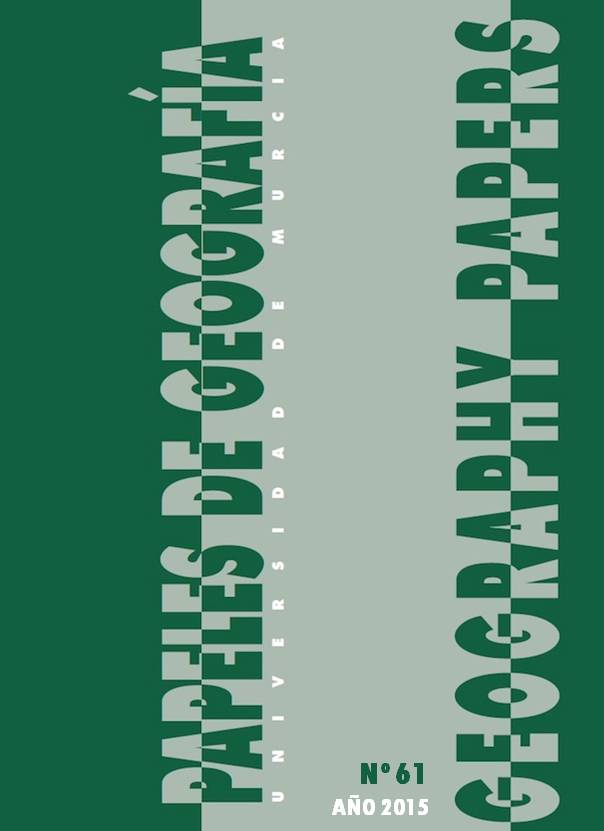Multifuncionalidad, partes interesadas y legitimidad social del regadío: aproximación a tres canales sur-europeos
Resumen
Multifuncionalidad, partes interesadas y legitimidad social del regadío: aproximación a tres canales sur-europeos
La gestión del regadío ha devenido protagonista de un debate multiescalar y supra temporal donde parte de la sociedad cuestiona sus límites socioeconómicos y ambientales, poniendo el énfasis en su capital territorial y su capacidad de adaptación ante los retos venideros. En el ámbito sur-europeo la yuxtaposición de canales tradicionales, modernizados y de nueva creación explica buena parte del dinamismo protagonizado por la matriz rural. El análisis del carácter multifuncional de tres casos de estudio sur-europeos (canal Segarra-Garrigues –Lérida–, canal de la Neste –Hautes-Pyrénées– y canal de la Muzza –Lombardia–) permite adentrarse en el debate sobre el futuro del regadío.
Descargas
Citas
ANTUNES, P. et al. (2009). Ecological Economics. “Participation and evaluation for sustainable river basin governance”, nº 68, p. 931-939.
ARMITAGE, D. (2005). Environmental Management. “Adaptive capacity and community-based natural resource management”, vol. 35, nº 6, p. 703-715.
AUMAND, A. et al. (2005). Ekonomia. “Multifunctional agriculture in perspective: Conceptualisations and debate in french policy and research”, vol. 367, nº 4, p. 11-18.
BODIN, Ö. y CRONA, B. I. (2009). Global Environmental Change. “The role of social networks in natural resource governance: What relational patterns make a difference?”, nº 19, p. 366-374.
BOSSIO, D.; GEHEB, K. y CRITCHLEY, W. (2009). Agricultural Water Management. “Managing water by managing land: Addressing land degradation to improve water productivity and rural livelihoods”, nº 97, p. 536-542.
BRUMMEL, R.F. y NELSON, K.C. (2014). Journal of Environmental Management. “Does multifunctionality matter to US farmers? Farmer motivations and conceptions of multifunctionality in dairy systems”, nº 146, p. 451-462.
BRUNSTAD, R.J.; GAASLAND, I. y VARDAL, E. (2005). European Review of Agricultural Economics. “Multifunctionality of agriculture: an inquiry into the complementary between landscape preservation and food security”, vol. 32, nº 4, p. 469-488.
COCKLIN, C.; DIBDEN, J. y MAUTNER, N. (2006). The Geographic Journal. “From market to multifunctionality? Land stewardship in Australia”, vol. 172, nº 3, p. 197-205.
DE FRAITURE, C.; MOLDEN, D. y WICHELNS, D. (2010). Agricultural Water Management. “Investing in water for food, ecosystems, and livelihoods: An overview of the comprehensive assessment of water management in agriculture”, vol. 97, nº 4, p. 495-501.
DE ROOIJ, S. et al. (2013). Sociologia Ruralis. “Sustaining food production through multifunctionality: The dynamics of large farms in Italy”, vol. 54, nº 3, p. 303-320.
DOBBS, T.L. y PRETTY, J.N. (2004). Review of Agricultural Economics. “Agri-Environmental stewardship schemes and “multifunctionality””, vol. 26, nº 2, p. 220-237.
DOWNWARD, S. y TAYLOR, R. (2007). Journal of Environmental Management. “An assessment of Spain’s Programa AGUA and its implications for sustainable water management in the province of Almeria, southeast Spain”, vol. 82, nº 2, p. 277-289.
FISCHER, G. et al. (2007). Technological Forecasting & Social Change. “Climate change impacts on Irrigation water requirements: effects of mitigation, 1980-2080”, nº 74, p. 1083-1107.
FLORA, C.B. (2012). Contemporary Sociology, A journal of reviews. “Sustainability unpacked: food, energy and water for resilient environments and societies”, vol. 41, nº 5, p. 679-681.
FOLEY, J.A. et al. (2005). Science. “Global consequences of land use”, vol. 309, nº 5734, p. 570-574.
FOLKE, C. (2007). Ecological Research. “Social–ecological systems and adaptive governance of the commons”, vol. 11, nº 1, p. 14-15.
FULLER, A.M. (1990). Journal of Rural Studies. “From part-time farming to pluriactivity: A decade of change in rural Europe”, vol. 6, nº 4, p. 361-373.
GARROD, B.; WORNELL, R. y YOUELL, R. (2006). Journal of Rural Studies. “Re-conceptualising rural resources as countryside capital: The case of rural tourism”, nº 22, p. 177-128.
GRAVELINE, N. y MÉREL, P. (2014). European Review of Agricultural Economics. “Intensive and extensive margin adjustments for water scarcity in France’s cereal belt”, vol. 41, nº 5, p. 707-743.
HALL, C.; MCVITTIE, A. y MORAN, D. (2004). Journal of Rural Studies. “What does the public want from agricultura and the countryside? A review of evidence and methods”, nº 20, p. 211-225.
HERMOSILLA, J. (dir.). (2010). Los regadíos históricos españoles: Paisajes culturales, paisajes sostenibles. Madrid: Ministerio de Medio Ambiente y Medio Rural y Marino, 608 p.
HERRICK, C. y PRATT, J. (2012). Nature + Culture. “Sustainability in the water sector: enabling lasting change through leadership and cultural transformation”, vol. 7, nº 3, p. 285-313.
HERVIEU, B. (2002). Cahiers Agricultures. “La multifonctionnalité de l’agriculture: genèse et fondements d’une nouvelle approche conceptuelle de l’activité agricole”, vol. 11, nº 6, p. 415-419.
HOUSTON, W. y GRIFFITHS, R. (2008). Water. The final resource: How the politics of water will impact on the world. Hampshire: Harriman House, 165 p.
IGLESIAS, A. et al. (2011). Environmental Science & Policy, “Re-thinking water policy priorities in the Mediterranean region in view of climate change”, nº 14, p. 744-757.
KAIKA, M. (2006). Annals, Association of American Geographers. “Dams as Symbols of Modernization: the Urbanization of Nature Between Geographical Imagination and Materiality”, nº 96, p. 276-301.
KHAN, S. y MUSHTAQ, S. (2009). Agricultural Water Management. “Regional partnerships to assist public-private investments in irrigation system”, nº 96, p. 839-846.
KNOX, J.W.; KAY, M.G. y WEATHERHEAD, K.E. (2012). Agricultural Water Management. “Water regulation, crop production, and agricultural water management: Understanding farmer perspectives on irrigation efficiency”, nº 108, p. 3-8.
LATERRA, P.; ORÚE, M.E. y BOOMAN, G.C. (2012). Agriculture, Ecosystems & Environment. “Spatial complexity and ecosystem services in rural landscapes”, nº 154, p. 56-67.
LEMAIRE, G. et al. (2014). Agriculture, Ecosystems & Environment. “Integrated crop-livestock systems: Strategies to achieve synergy between agricultural production and environmental quality”, vol. 190, nº 1, p. 4-8.
LEVIN, S.A. (2006). Ecological Research. “Learning to live in a global commons: socioeconomic challenges for a sustainable environment”, nº 21, p. 328-333.
LIENERT, J., SCHNETZER, F. e INGOLD, K. (2013). Journal of Environmental Management. “Stakeholder analysis combined with social network analysis provides fine-grained insights into water infrastructure planning processes”, nº 125, p. 134-148.
MALORGIO, G. (2008). Options méditerranéennes. “L’agriculture, l’agroalimentaire, la pêche et le développement rural en Italie”, Serie B, nº 61, p. 265-293.
MARSDEN, T. y SONNINO, R. (2008). Journal of Rural Studies. “Rural development and the regional State: denying multifuncitional agriculture in UK”, nº 24, p. 422-431.
MATA, R. (2008). ARBOR, Ciencia, Pensamiento y Cultura. “El paisaje, patrimonio y recurso para el desarrollo territorial sostenible. Conocimiento y acción pública”, nº 729, p. 155-172.
MOONEN, A-C. y BÀRBERI, P. (2008). Agriculture, Ecosystems & Environment. “Functional biodiversity: An agroecosystem approach”, nº 127, p. 7-21.
MORGAN, S.Ll. et al. (2010). Journal of Rural Studies. “Agricultural multifunctionality and farmers’ entrepeneurial skills: A study of Tuscan and Welsh farmers”, nº 26, p. 116-129.
NAMARA, R.E. et al. (2010). Agricultural water Management. “Agricultural water management and poverty linkages”, nº 97, p. 520-527.
NILSSON, P. (2002). Annals of Tourism Research. “Staying on farms. An ideological background”, vol. 29, nº 1, p. 7-24.
ÖZEROL, G.; BRESSERS, H. y COENEN, F. (2012). Environmental Science & Policy. “Irrigated agriculture and environmental sustainability: an alignment perspective”, nº 23, p. 57-67.
PAHL-WOSTL, C. (2007). Environmental Modelling and Software. “The implications of complexity for integrated resources management”, nº 22, p. 561-569.
PAHL-WOSTL, C. y KRANZ, N. (2010). Environmental Science & Policy. “Water governance in times of change”, nº 13, p. 567-570.
PARDEY, P.G. et al. (2014). Australian Journal of Agricultural and Resource Economics. “A bounds analysis of world food futures: Global agriculture through to 2050”, nº 58, p. 571-589.
POTTER, C. y BURNEY, J. (2002). Journal of Rural Studies. “Agricultural multifunctionality in the WTO – legitimate non-trade concern or disguised protectionism?”, vol. 18, nº 1, p. 35-47.
POTTER, C. y TILZEY, M. (2007). Geoforum. “Agricultural multifunctionality, environmental sustainability and the WTO: resistance or accommodation to the neoliberal project for agriculture?”, nº 38, p. 1290-1303.
PRELL, C., HUBACEK, K. y REED, M. (2009). Society and Natural Resources. “Stakeholder analysis and social network analysis in natural resource management”, nº 22, p. 501-518.
RANDALL, A. (2002). European Review of Agricultural Economics. “Valuing the outputs of multifunctional agriculture”, vol. 29, nº 3, p. 289-307.
RICART, S. y CLARIMONT, S. (2013). Sud-Ouest Européen. “De la gouvernance appliquée à la gestion de l’irrigation: le cas du canal de la Neste (Hautes-Pyrénées)”, nº 35, p. 69-84.
RICART, S.; RIBAS, A. y PAVÓN, D. (2013). Méditerranée. “La participación en la gestión del regadío como mecanismo para afrontar el conflicto territorial: algunos ejemplos de ámbito sur-europeo”, nº 120, p. 73-86.
STRZEPEK, K. y BOEHLERT, B. (2010). Philosophical Transactions of the Royal Society Biological Sciences. “Competition for water for the food system”, nº 365, p. 2927-2940.
TILMAN, D. y CLARK, M. (2014). Nature. “Global diets link environmental sustainability and human health”, vol. 515, nº 7528, p. 518-522.
TURRAL, H.; SVENDSEN, M. y FAURES, J.M. (2010). Agricultural Water Management. “Investing in irrigation: Reviewing the past and looking the future”, nº 97, p. 551-560.
VIGLIZZO, E.F. et al. (2012). Agriculture, Ecosystems & Environment. “Ecosystem service evaluation to support land-use policy”, nº 154, p. 78-84.
VINCENT, J.R. (2007). Ecological Research. “Spatial dynamics, social norms, and the opportunity of the commons”, nº 22, p. 3-7.
WILSON, G.A. (2001). Transactions of the Institute of British Geographers. “From productivism to postproductivism ... and back again? Exploring the (un)changed natural and mental landscapes of European agriculture”, nº 26, p. 77-102.
WRIEDT, G. et al. (2009). Journal of Hydrology. “Estimating irrigation water requirements in Europe”, nº 373, p. 527-544.
Las obras que se publican en esta revista están sujetas a los siguientes términos:
1. El Servicio de Publicaciones de la Universidad de Murcia (la editorial) conserva los derechos patrimoniales (copyright) de las obras publicadas, y favorece y permite la reutilización de las mismas bajo la licencia de uso indicada en el punto 2.
2. Las obras se publican en la edición electrónica de la revista bajo una licencia Creative Commons Reconocimiento-NoComercial 4.0 (texto legal). Se pueden copiar, usar, difundir, transmitir y exponer públicamente, siempre que: i) se cite la autoría y la fuente original de su publicación (revista, editorial y URL de la obra); ii) no se usen para fines comerciales; iii) se mencione la existencia y especificaciones de esta licencia de uso.
3. Condiciones de auto-archivo. Se permite y se anima a los autores a difundir electrónicamente las versiones pre-print (versión antes de ser evaluada) y/o post-print (versión evaluada y aceptada para su publicación) de sus obras antes de su publicación, ya que favorece su circulación y difusión más temprana y con ello un posible aumento en su citación y alcance entre la comunidad académica. Color RoMEO: verde.









